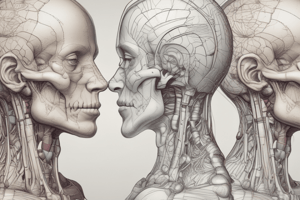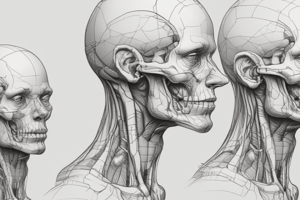Podcast
Questions and Answers
What is the term for a narrow opening between adjacent parts of bones for nerves and vessels?
What is the term for a narrow opening between adjacent parts of bones for nerves and vessels?
- Meatus
- Foramen
- Sulcus
- Fissure (correct)
Which bone forms the forehead and supplies the upper edge and roof of the orbit?
Which bone forms the forehead and supplies the upper edge and roof of the orbit?
- Occipital Bone
- Sphenoid Bone
- Parietal Bone
- Frontal Bone (correct)
What is the term for a prominent border or ridge on a bone?
What is the term for a prominent border or ridge on a bone?
- Epicondyle
- Trochanter
- Linea
- Crest (correct)
How many bones make up the Cranium?
How many bones make up the Cranium?
What is the term for a small rough process on a bone?
What is the term for a small rough process on a bone?
What is the term for a large rounded prominence on a bone?
What is the term for a large rounded prominence on a bone?
How many bones make up the Face?
How many bones make up the Face?
What is the term for a shallow depression on a bone?
What is the term for a shallow depression on a bone?
What can block the glands and stop the flow of saliva?
What can block the glands and stop the flow of saliva?
What type of bacteria can cause sialadenitis?
What type of bacteria can cause sialadenitis?
Which age groups are most likely to develop sialadenitis?
Which age groups are most likely to develop sialadenitis?
What is Sjogren syndrome characterized by?
What is Sjogren syndrome characterized by?
What is the main function of the paranasal sinuses?
What is the main function of the paranasal sinuses?
What type of tumors can form in the salivary glands?
What type of tumors can form in the salivary glands?
What is another term for the arches in the upper part of the throat?
What is another term for the arches in the upper part of the throat?
What is the inflammation of the tonsils in the upper part of the throat?
What is the inflammation of the tonsils in the upper part of the throat?
What is the term for the enlargement of the tonsils without inflammation?
What is the term for the enlargement of the tonsils without inflammation?
What is the function of the styloglossus muscle?
What is the function of the styloglossus muscle?
What is the origin of the genioglossus muscle?
What is the origin of the genioglossus muscle?
What is the function of the transverse muscle?
What is the function of the transverse muscle?
What is the function of the superior longitudinal muscle?
What is the function of the superior longitudinal muscle?
What is the function of the sternocleidomastoid muscle?
What is the function of the sternocleidomastoid muscle?
What is the origin of the trapezius muscle?
What is the origin of the trapezius muscle?
What is the function of the platysma muscle?
What is the function of the platysma muscle?
What is the main function of the maxilla bones?
What is the main function of the maxilla bones?
Which of the following is a landmark of the maxilla?
Which of the following is a landmark of the maxilla?
What is the zygomatic bone also known as?
What is the zygomatic bone also known as?
Where is the lacrimal bone situated?
Where is the lacrimal bone situated?
What is the function of the infra orbital foramen?
What is the function of the infra orbital foramen?
What is the characteristic of the lacrimal bone?
What is the characteristic of the lacrimal bone?
What is the point of intersection of the coronal and sagittal sutures on the skull?
What is the point of intersection of the coronal and sagittal sutures on the skull?
What is the function of the buccinator muscle?
What is the function of the buccinator muscle?
During what stage of life is the lambda membranous?
During what stage of life is the lambda membranous?
What is the name of the fontanelle that closes in the first 18-36 months of life?
What is the name of the fontanelle that closes in the first 18-36 months of life?
What is the origin of the buccinator muscle?
What is the origin of the buccinator muscle?
What is the insertion of the buccinator muscle?
What is the insertion of the buccinator muscle?
Flashcards are hidden until you start studying
Study Notes
Regions of the Head
- Depressions and openings in bones: fissure (narrow opening between adjacent bones for nerves and vessels), foramen (hole), and meatus (tubelike passageway)
- Processes that form joints: condyle (large rounded prominence), facet (smooth flat surface), and head (rounded articular projection)
Gross Anatomy of the Skull (Cranium)
- Consists of 8 bones: frontal, 2 temporal, 2 parietal, occipital, sphenoid, and ethmoid bones
- Face consists of 14 bones: maxilla, zygomatic bones, lacrimal bones, palatine bones, nasal bones, inferior nasal conchae, vomer, and mandible
Bones of the Cranium
- Frontal bone: large bone that makes up the forehead and supplies the upper edge and roof of the orbit (eye socket)
Bones of the Face
- Maxilla: largest bones of the face, forms the upper jaw, and holds the upper teeth
- Landmarks: infra orbital foramen (hole below the orbit), alveolar process (arch of the maxilla containing the upper teeth), and palatine process (horizontal projection forming the anterior ¾ of the hard palate)
- Zygomatic bones: commonly referred to as the cheekbone, forms the prominence of the cheek and part of the lateral wall and floor of the orbit
- Lacrimal bones: smallest and most fragile bone of the face, contains the lacrimal sac and the naso-lacrimal duct
Myology of the Head and Neck
- Muscles of facial expression
- Muscles of mastication
- Muscles of the floor of the mouth
- Muscles of the soft palate
- Muscles of the tongue (extrinsic and intrinsic)
- Muscles of the neck
- Muscles of the pharynx
Muscles of the Tongue (Extrinsic)
- Styloglossus: originates from the styloid process of the temporal bone, inserts into the sides of the tongue, and functions to retract and elevate the tongue
- Genioglossus: originates from the superior part of the symphysis menti, inserts into the undersurface of the tongue, and functions to protrude and depress the tongue
- Hyoglossus: originates from the hyoid bone, inserts into the sides of the tongue, and functions to depress and retract the tongue
Muscles of the Tongue (Intrinsic)
- Transverse/horizontal muscle: originates from the median fibrous septum, inserts into the sides of the tongue, and functions to make the tongue narrow and elongated
- Vertical muscle: originates from the submucosal fibrous layer of the dorsum of the tongue, inserts into the inferior surface borders of the tongue, and functions to flatten and broaden the tongue
- Superior longitudinal muscle: originates from the median fibrous septum, inserts into the edges of the tongue, and functions to retract the tongue making it short and thick
- Inferior longitudinal muscle: originates from the root of the tongue, inserts into the apex of the tongue, and functions to retract the tongue making it short and thick
Muscles of the Neck
- Sternocleidomastoid: originates from the sternum and clavicle, inserts into the mastoid process, and functions to divide the neck into anterior and posterior triangles
- Trapezius: originates from the occipital bone, inserts into the clavicle and scapula, and functions to shrug the shoulders, rotate, retract, and elevate the scapula
- Platysma: originates from the clavicle, inserts into the base of the mandible, orbicularis oris, angle of the mouth, skin of the cheeks and lips, and functions to draw the angles of the mouth inferiorly
Cranial Nerves
- Not specified in this text
Studying That Suits You
Use AI to generate personalized quizzes and flashcards to suit your learning preferences.




